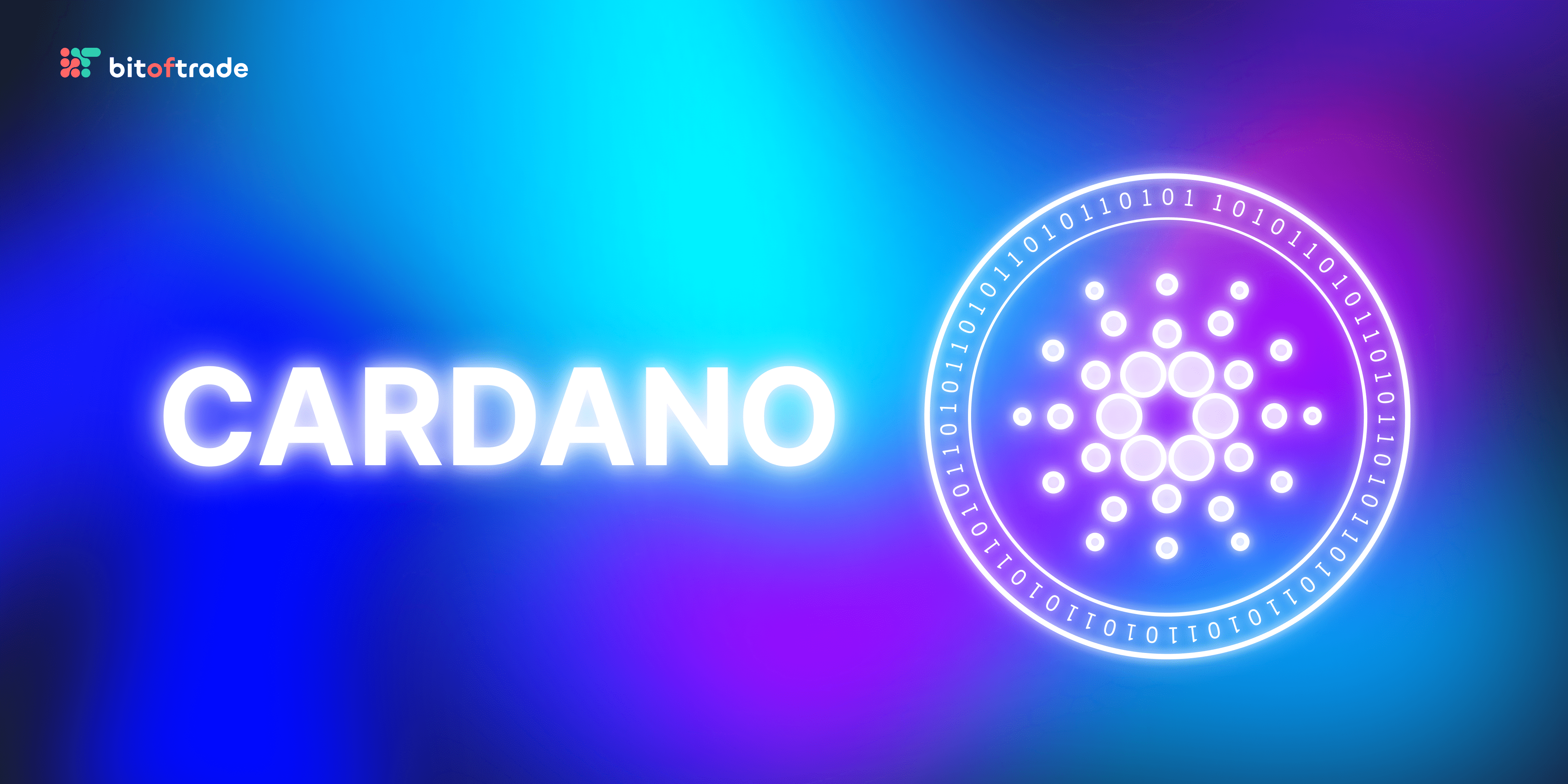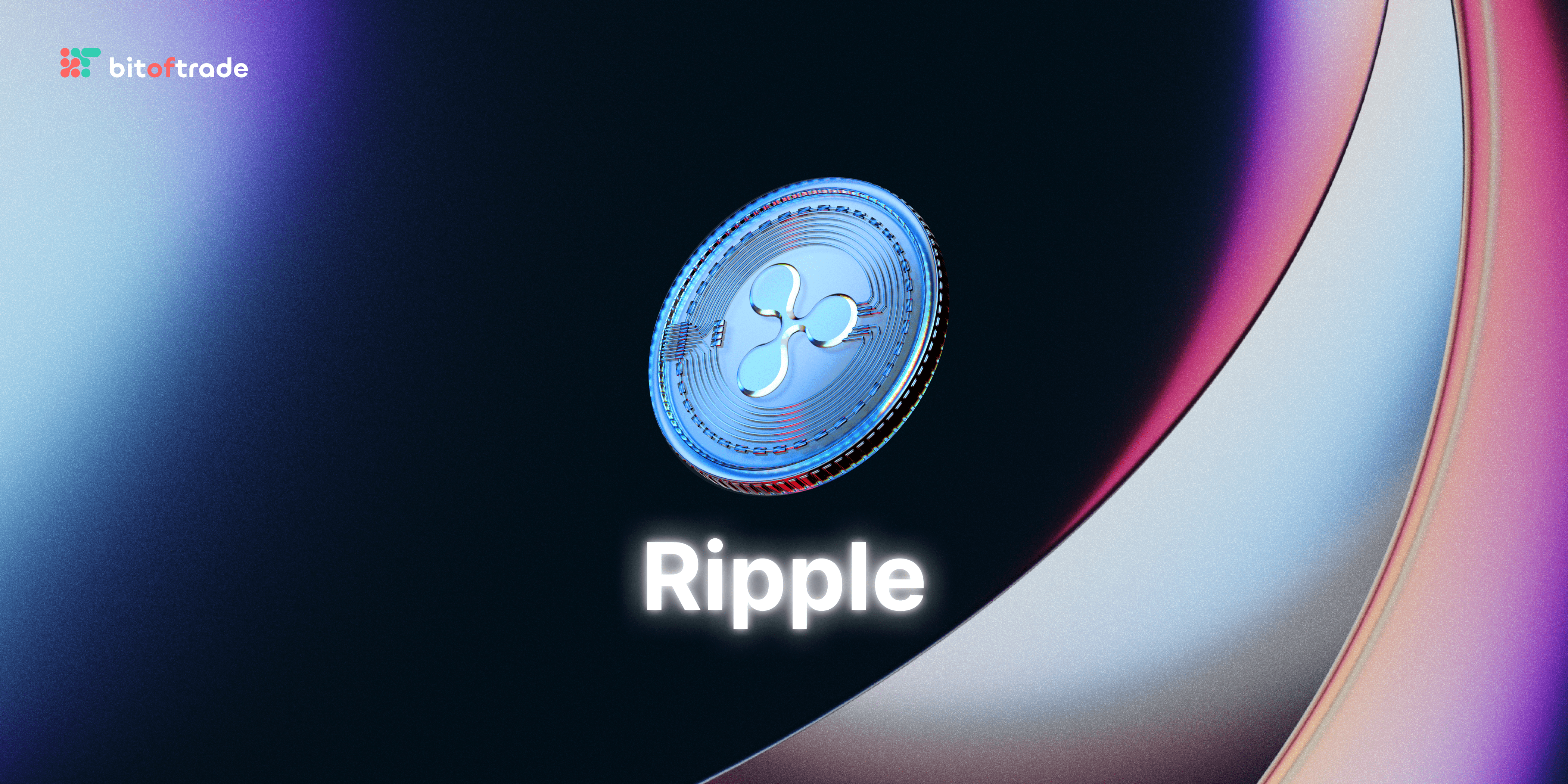Cardano is one of the greatest projects that are powered by the blockchain. The co-founder of Ethereum, Charles Hoskinson, and the group of developers and academic researchers started creating Cardano in 2015 and fully launched the platform in 2017.
This article will explore what Cardano is and how the team of this ecosystem made a unique blockchain product. Let's dive right into it!
What is so special about Cardano?
The project positions itself as a producer of scientific knowledge, striving to introduce advanced blockchain technologies into existing economic and managerial institutions. Indeed, according to Hoskinson, more than a hundred scientific studies were conducted by the company while inventing blockchain protocols, decentralized applications, and more. These articles have been cited more than 1000 times by other scientists. We think this confirms the relevance of the research produced by Cardano's researchers and associates.
You can judge the results of Cardano's theoretical and practical work simply by going to the IOHK online library, which is open to any user.
Cardano's founding partners are three separate firms, but collaborating to consolidate a single commercial Cardano strategy:
— The Cardano Foundation is a non-profit organization owning the Cardano brand.
CF, according to the institution itself, ‘’sets the direction for decentralized economic empowerment, working with regulators in different jurisdictions to shape blockchain legislation and commercial standards, and empowering the Cardano community to leverage the Cardano protocol to solve real-life problems.’’
— IOHK is an engineering company building cryptocurrency and blockchains.
Here's what the company's founders say about themselves:
‘The company builds high-assurance blockchain infrastructure solutions for public, private sector and government clients.’
— EMURGO is a multinational blockchain technology company that aims to promote the adoption of Cardano.
Here is how the organization is described on the official website:
‘EMURGO develops enterprise-grade applications, builds developer tools, invests in startups, and provides blockchain education.’

Ouroboros consensus explained. What is this?
The consensus protocol is the mechanism used to reach an agreement between network members to add new transactions to the ledger. In 2017, Cardano implemented a consensus mechanism named Ouroboros. It is a longest chain protocol based on Proof-of-Stake.
As Hoskinson said, the goal of Cardano researchers is to establish a mathematically reviewed consensus protocol using Proof-of-Stake with the same security properties as Bitcoin.
Realizing all the virtues of the very first blockchain technology that exploded, the creators of Cardano, however, did not want to reproduce the disadvantages of Bitcoin based on Proof-of-Work consensus — centralization (a single player, Bitmain, controls over 40% of the network hash rate), transaction processing speed and environmental impact.
The Ouroboros protocol is more like Ethereum, however, they are not the same.
There is a basic Proof-of-Stake consensus where each user is running a node where they lock up their stake (and the validator node takes part in consensus). But there are also several variations of this mechanism. Cardano uses DPOS — Delegated Proof-of-Stake.
In the DPOS network, users can pool their stake together and delegate it to someone running a validator node. Often, such networks are more centralized than classic Proof-of-Stake since a small number of validator nodes are needed (usually within a hundred) to run the network.
Cardano's Ouroboros protocol uses DPOS but without limiting the number of validator nodes and does not require expensive hardware making its ruling approach much more democratic than other crypto projects. There are currently more than 2,500 stake pools in the ecosystem, setting the pace for internal competition and promoting more decentralization.
How Cardano blockchain network works?
Cardano's developers use a functional programming Haskell language, requiring a high degree of formal verification. Plutus and Marlowe are smart contract programming language and domain-specific language for financial smart contracts built on Haskell.
Cardano introduced the concept of Stake Delegation. Any stakeholder who has allocated their ADA to a stake pool can delegate their participation rights in the protocol to a particular pool ID. Stakeholders who have delegated to a stake pool are rewarded with ADA native currency for participating in the network.
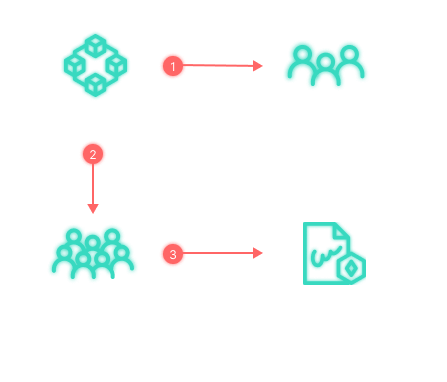
You can calculate how much you can reward staking ADA here.
There are more than 2500 stake pools available. To select the stake pool, you want to transfer your ADA, you can check out the Pool.Tool.io website.
Thanks to the Ouroboros mechanism, the security of which was scientifically proven by Aggelos Kiayias. The rewards-sharing scheme distributes rewards in such a way that there is no chance to build monopoly pools, as, for example, in bitcoin mining — an ecosystem that should be completely decentralized but a significant share of BTC mined by only a few large farms.
Quoting an official IOHK source:
‘The scheme is also designed so that as soon as the stake delegated to a single pool increases above a certain threshold, the rewards diminish. That encourages ada holders to switch to a different pool to improve their rewards.’
Cardano roadmap 2022. Where to go next?
The Cardano roadmap consists of five stages, named after the great figures of world culture.
The first stage — the project launch stage — was named after the English poet George Byron. As a result of the developments, ADA has become a sought-after currency on more than 30 exchanges, and Cardano has developed a rather large global community of crypto enthusiasts.
The Byron era was a time of fundamental developments: the protocol Ouroboros and the native currency ADA were launched, wallets were created, and much more that you can see here.
The next step towards building a powerful decentralized blockchain technology is the Shelley era, named after the writer who created the Frankenstein novel. This period is characterized by a desire for greater decentralization and a detailed study of the network. In the Shelley era, the introduction of a delegation and reward system took place, the number of stake pools exceeded 1000. You can find out more here.
The key task of the next era named after Joseph Goguen was the creation of Plutu's, a purpose-built smart contract development language, as well as Marlowe, a domain-specific language that allows you to create financial apps. Based on Cardano, it becomes possible to create fungible and non-fungible tokens, as well as decentralized applications. Read more about the Goguen era.
Now, Cardano is at the stage called Basho, a 17th-century Japanese poet. Basho's focus is on optimization and scalability. The developers set out to create sidechains to the Cardano blockchain, as well as implement the ability to use an account model for transactions, not only UTXO. At the end of September 2022, a major update was released — Vasil hard fork.
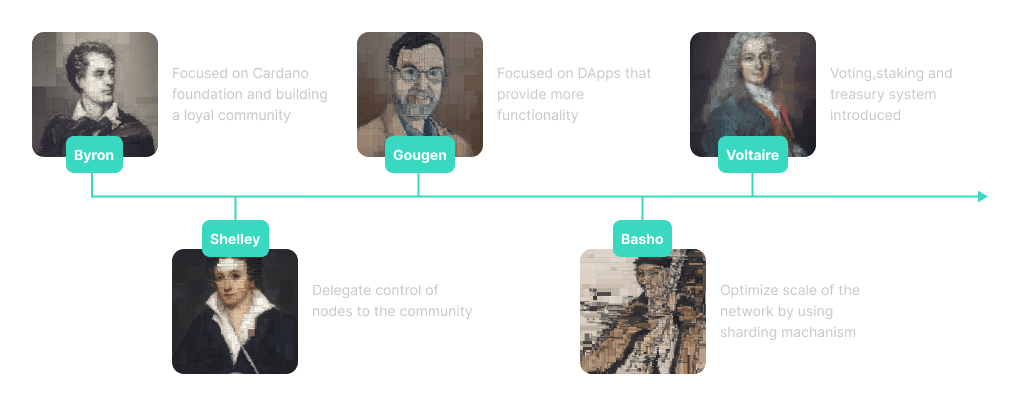
Vasil Hard Fork Update. What to expect?
The Vasil update is one of the major updates within the Basho phase of Cardano's roadmap. Several times postponed, the update took place on September 22, 2022, and on September 27, all the Plutu's features officially became available.
As a consequence of the Vasil hard fork, an expansion of dApps in the Cardano ecosystem is expected.
We propose to briefly describe the main new features introduced during the hard fork preparation.
Cardano Improvement Proposals (CIPs):
— Reference inputs (CIP-31)
The CIP-31 proposal will allow access to transaction outputs without having to recreate or spend them. This will make the process more streamlined and time-saving.
— Inline datums (CIP-32)
CIP-32 is about attaching datums to outputs instead of hashes. What does it mean? With CIP-32 developers will code scripts to the inputs directly without the need to store full datum.
— Reference Scripts (SIP-33)
Developers will be able to choose an address to receive the collateral change. So, in the case of a failing transaction, only the collateral amount is taken.
With SIP-33 transactions will get smaller, and the process of validation more efficient. This proposal attaches reference scripts to outputs.
Another post-Vasil improvement is the implementation of diffusion pipelining. This is a solution aimed at increasing the block size and the scale of the network. The diffusion pipelining allows transmitting blocks without full validation and improves block propagation times, enabling higher throughput.
Cardano Africa project. What is Cardano’s strategy?
Cardano, as a third-generation cryptographic technology, aims to foster digital innovations around Africa. As Charles Hoskinson said, the purpose of Cardano Africa project is to deliver ‘the economic identity to those who don’t have it.’
Early on, Cardano moved to Ethiopia, working with government institutions to create national data privacy laws and the Ethiopian identity system. In 2021, with the support of the Ethiopian Ministry of Education, a decentralized web application called Atala Prism was integrated.
As reported by John O’Connor, by May 5, 2022, up to two million Ethiopian students were fully onboarded and used the Prism software. In total, according to the plan, the application will be distributed to five million people.
What is Prism? This system allows users to verify credentials and certificates, to create a personal ID and a bank account for exchanging, withdrawing and transferring money. It is assumed that within the system stored in the user's smartphone, medical and academic records can be safely stored. There are even initiatives to use this app to vote in elections. So, Prism is a personal data store.
How is it possible to keep all personal information safe and secure?
This self-sovereign identity (SSI) platform stores the user's metadata, is encrypted in code and does not contain any information that identifies the user. As the study states, 'even when decrypted by third parties, the metadata will not contain any credentials or other personal information which might directly identify the holder.'
You can think of Atala Prism as a MetaMask non-custodial wallet that gives the user full control over the assets. Each user has a public key that identifies a specific address and completed transactions and a private key that belongs exclusively to the user.
ADA price prediction
ADA is the native token of the Cardano ecosystem. It is used to pay transaction fees, earn staking rewards, vote on changes to the protocol, and more. Of course, ADA can also be traded and staked.
It is worth saying that now about 70% of ADA are in stake pools, the rest is in free circulation. The stakers of this currency receive a 4.6% reward per year, which can be compared with the performance of ETH stakers (approximately 4.3%).
According to data provider Staking Rewards, Cardano is ranked third in the Top 10 Crypto Assets.
Let's look at ADA technical analysis data at different time frames.
Today, based on the technical indicators, we see the following picture. In the current bear market conditions, Sell performance should not scare you, as this is typical for almost any cryptocurrency at this time:
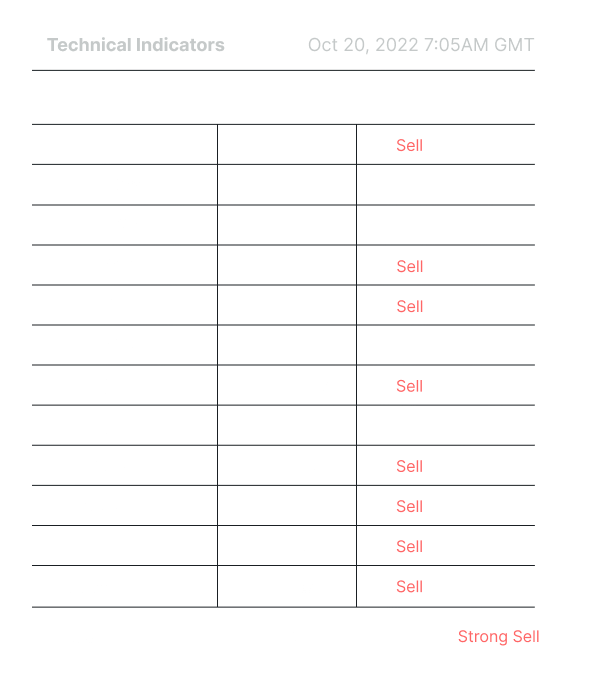
For instance, the same thing happens with SOL:
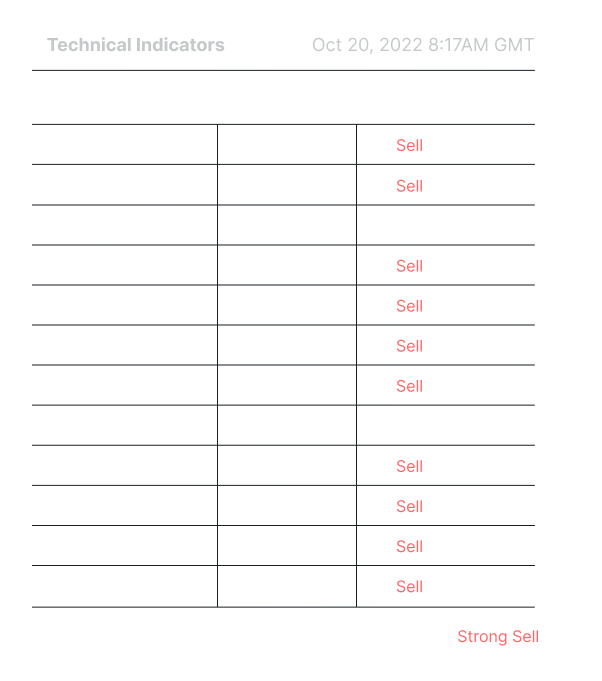
Or you can look at technical analysis of the DOT token:

On a weekly basis we can see the following:
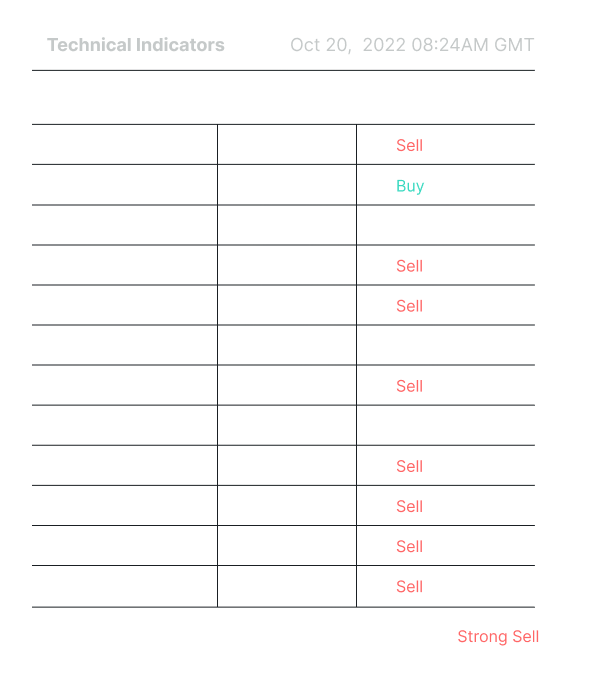
Over the past week, ADA coin has fallen more deeply than other altcoins — by 2.27%. In general, the crypto market saw growth during the week. So, let's say, MATIC increased by 13.60%, UNI — by 15.30%. Growth leaders for many days are QNT (19.75% weekly growth), EGLD (10.54% weekly growth), and XRP has slowed down its movement to growth.
ADA seems to be in no hurry to enter a bullish trend. Maybe Cardano will be your winning long-term investment, because the market does not freeze at the point of decline forever, and we have already seen recovery increase several times over the past years.
Conclusion
Cardano is a project created by enthusiastic academics, and despite some slowness and careful checking of all possible errors, Cardano and its projects are among the top ten crypto projects by market capitalization.
The creators of Cardano see their goal not only in creating the most demanded currency and protocol for decentralized applications but also in ensuring that every element of their work is scientifically substantiated and rechecked and creating favorable conditions for the use of scientific developments for users and other developers.
The creators of Cardano, and IOHK, are doing a great educational job — for this one has only to look at the websites of the Cardano organizations and the YouTube channel. Cardano not only creates a product but teaches how to use it.
But to objectively assess the possibilities and potential of Cardano, we advise you to get acquainted with alternative sources of information, not only official documents but also the experience of users who have dealt with the Cardano network.
By the way, on the decentralized bitoftrade platform, you can exchange Binance-peg Cardano token on Binance Smart Chain network.
We also recommend that you read the bitoftrade articles, where we talk briefly and clearly about the most important things in the world of crypto.
Subscribe to our YouTube channel to find out in a few minutes how to trade on bitoftrade: everything from connecting a non-custodial wallet to making leveraged trades.
Check out our social networks to stay up to date with the latest news:
